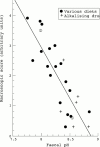Leucocyte endothelial cell adhesion in indomethacin induced intestinal inflammation is correlated with faecal pH
- PMID: 9577345
- PMCID: PMC1727044
- DOI: 10.1136/gut.42.3.380
Leucocyte endothelial cell adhesion in indomethacin induced intestinal inflammation is correlated with faecal pH
Abstract
Background: Recent studies indicate that faecal pH is acidified in patients with inflammatory bowel disease compared with healthy controls. In healthy volunteers, stool pH, faecal flora, and bile acid concentration could be affected by means of elemental diets.
Aims: To assess the role of variations of faecal pH on leucocyte endothelial cell adhesion in indomethacin induced long lasting ileitis in rats.
Methods: Indomethacin (7.5 mg/kg subcutaneously) was injected twice, 24 hours apart. Rats were either fed with the identical diet before and 10 days after the induction of inflammation until the experiment, or the diet was changed at the time of induction. Ten postcapillary mesenteric venules (30 microns diameter) per animal were observed using intravital microscopy. Macroscopic visible intestinal ulceration was scored and faecal pH of different sections of the small bowel was determined.
Results: Small intestinal faecal pH was 8.5 in controls and 8.0 in indomethacin treated animals. Indomethacin significantly changed microcirculatory parameters: there was a 2.3-fold increase in leucocyte adherence, a 3.2-fold increase in leucocyte emigration, and a 20% reduction in shear rate. Application of various diets or diet combinations resulted in variations in faecal pH ranging from 7.8 to 8.8 which were inversely correlated with macroscopic ulcerations (r = -0.67). Leucocyte adherence was attenuated with increased pH and augmented with decreased pH (r = -0.55). Venular wall shear rate was positively correlated with faecal pH (r = 0.48) while leucocyte emigration showed no correlation. Leucocyte rolling velocity was not significantly altered. Normalisation of faecal pH by different alkalising drugs induced a significant decrease in leucocyte adherence in standard fed, indomethacin treated rats.
Conclusions: Faecal pH is lowered in the indomethacin model of long lasting ileitis in rats, which is similar to human inflammatory bowel disease. Alkalisation of faecal pH due to different diets or alkalising drugs reduces indomethacin induced leucocyte endothelial cell adhesion and macroscopic intestinal damage. These results may provide a rationale for the therapeutic effect of enteral diets in Crohn's disease.
Figures




Similar articles
-
Glutamine attenuates leukocyte-endothelial cell adhesion in indomethacin-induced intestinal inflammation in the rat.JPEN J Parenter Enteral Nutr. 1999 Jan-Feb;23(1):12-8. doi: 10.1177/014860719902300112. JPEN J Parenter Enteral Nutr. 1999. PMID: 9888412
-
Lactulose and neomycin attenuate leukocyte-endothelial cell adhesion in an animal model of inflammatory bowel disease.Eur J Gastroenterol Hepatol. 1998 Apr;10(4):339-43. doi: 10.1097/00042737-199804000-00011. Eur J Gastroenterol Hepatol. 1998. PMID: 9855051
-
Leucocyte-endothelial cell adhesion in a model of intestinal inflammation.Gut. 1995 Sep;37(3):374-9. doi: 10.1136/gut.37.3.374. Gut. 1995. PMID: 7590433 Free PMC article.
-
Faecal parameters in the assessment of activity in inflammatory bowel disease.Scand J Gastroenterol Suppl. 1999;230:106-10. doi: 10.1080/003655299750025624. Scand J Gastroenterol Suppl. 1999. PMID: 10499470 Review.
-
Leucocyte-endothelial interactions in health and disease.Handb Exp Pharmacol. 2006;(176 Pt 2):97-133. doi: 10.1007/3-540-36028-x_4. Handb Exp Pharmacol. 2006. PMID: 16999226 Review.
References
Publication types
MeSH terms
Substances
LinkOut - more resources
Full Text Sources
Medical
